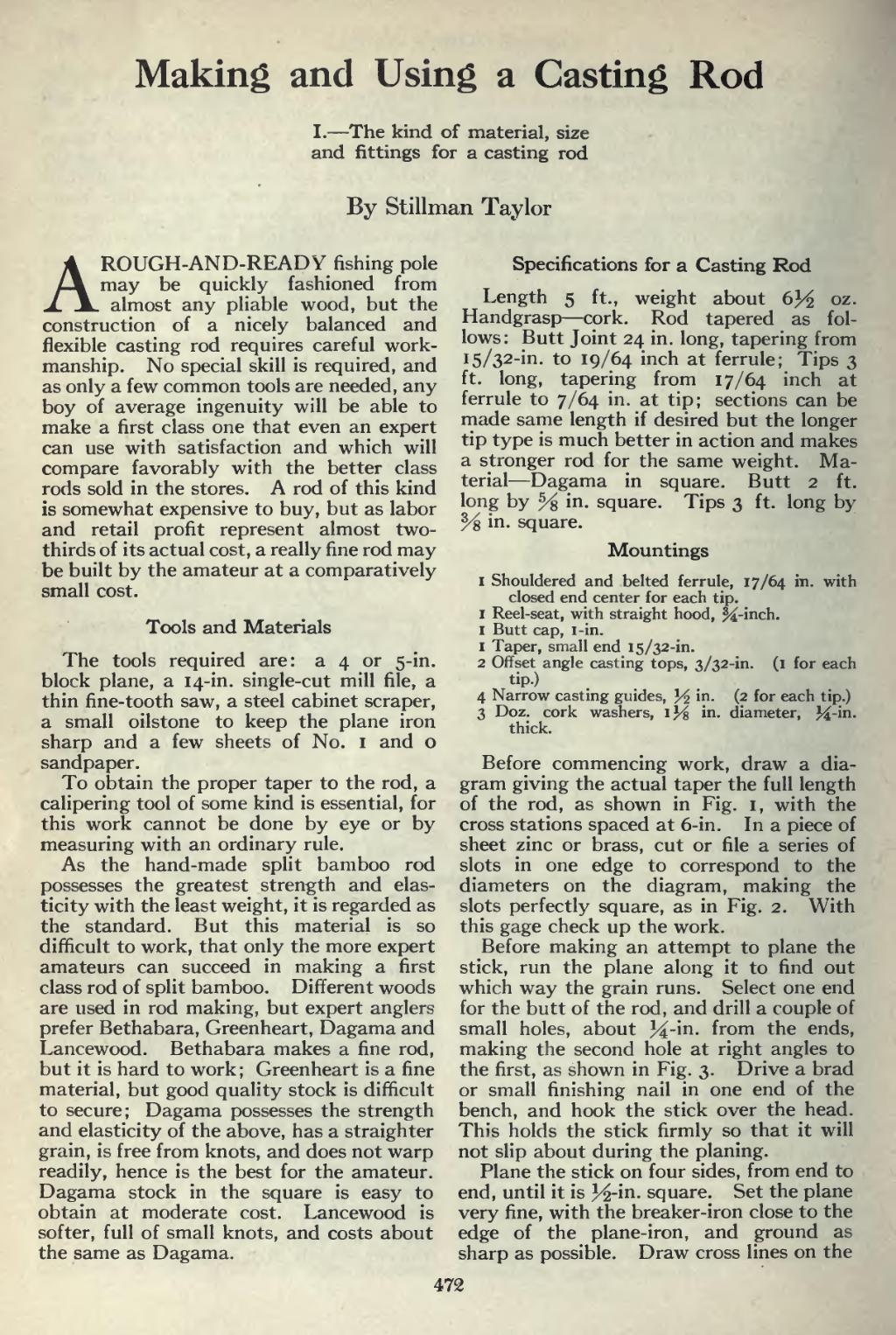Making and Using a Casting Rod
I. — The kind of material, size and fittings for a casting rod
By Stillman Taylor
��A ROUGH-AND-READY fishing pole may be quickly fashioned from almost any pliable wood, but the construction of a nicely balanced and flexible casting rod requires careful work- manship. No special skill is required, and as only a few common tools are needed, any boy of average ingenuity will be able to make a first class one that even an expert can use with satisfaction and which will compare favorably with the better class rods sold in the stores. A rod of this kind is somewhat expensive to buy, but as labor and retail profit represent almost two- thirds of its actual cost, a really fine rod may be built by the amateur at a comparatively small cost.
Tools and Materials
The tools required are: a 4 or 5-in. block plane, a 14-in. single-cut mill file, a thin fine-tooth saw, a steel cabinet scraper, a small oilstone to keep the plane iron sharp and a few sheets of No. 1 and o sandpaper.
To obtain the proper taper to the rod, a calipering tool of some kind is essential, for this work cannot be done by eye or by measuring with an ordinary rule.
As the hand-made split bamboo rod possesses the greatest strength and elas- ticity with the least weight, it is regarded as the standard. But this material is so difficult to work, that only the more expert amateurs can succeed in making a first class rod of split bamboo. Different woods are used in rod making, but expert anglers prefer Bethabara, Greenheart, Dagama and Lancewood. Bethabara makes a fine rod, but it is hard to work; Greenheart is a fine material, but good quality stock is difficult to secure; Dagama possesses the strength and elasticity of the above, has a straighter grain, is free from knots, and does not warp readily, hence is the best for the amateur. Dagama stock in the square is easy to obtain at moderate cost. Lancewood is softer, full of small knots, and costs about the same as Dagama.
��Specifications for a Casting Rod
Length 5 ft., weight about 6^2 oz. Handgrasp — cork. Rod tapered as fol- lows: Butt Joint 24 in. long, tapering from J 5/3 2 -' m - to 19/64 inch at ferrule; Tips 3 ft. long, tapering from 17/64 inch at ferrule to 7/64 in. at tip; sections can be made same length if desired but the longer tip type is much better in action and makes a stronger rod for the same weight. Ma- terial — Dagama in square. Butt 2 ft. long by % in. square. Tips 3 ft. long by % in. square.
Mountings
I Shouldered and belted ferrule, 17/64 in. with
closed end center for each tip. 1 Reel-seat, with straight hood, %-i n ch. I Butt cap, i-in.
1 Taper, small end 15/32-in.
2 Offset angle casting tops, 3/32-in. (1 for each
tip.) 4 Narrow casting guides, 3^ in- (2 for each tip.)
3 Doz. cork washers, \Y% in. diameter, K-in.
thick.
Before commencing work, draw a dia- gram giving the actual taper the full length of the rod, as shown in Fig. 1, with the cross stations spaced at 6-in. In a piece of sheet zinc or brass, cut or file a series of slots in one edge to correspond to the diameters on the diagram, making the slots perfectly square, as in Fig. 2. With this gage check up the work.
Before making an attempt to plane the stick, run the plane along it to find out which way the grain runs. Select one end for the butt of the rod, and drill a couple of small holes, about }/i-'m. from the ends, making the second hole at right angles to the first, as shown in Fig. 3. Drive a brad or small finishing nail in one end of the bench, and hook the stick over the head. This holds the stick firmly so that it will not slip about during the planing.
Plane the stick on four sides, from end to end, until it is ^-in. square. Set the plane very fine, with the breaker-iron close to the edge of the plane-iron, and ground as sharp as possible. Draw cross lines on the
��472
�� �
